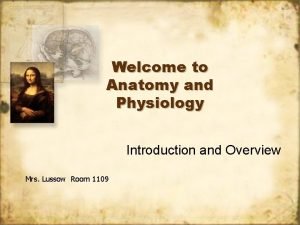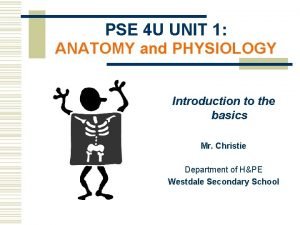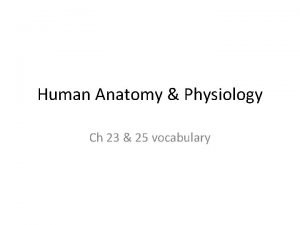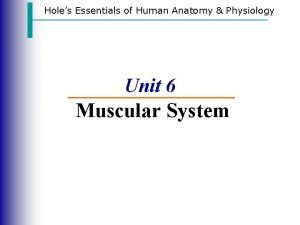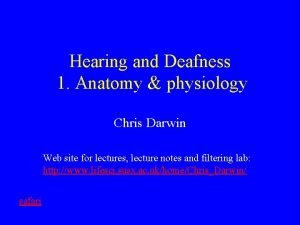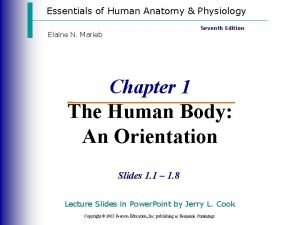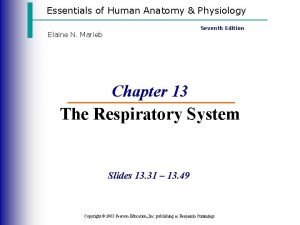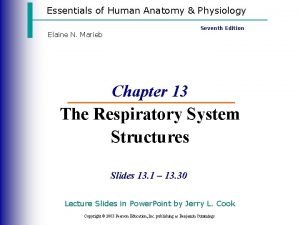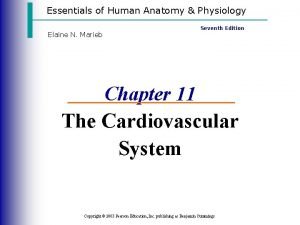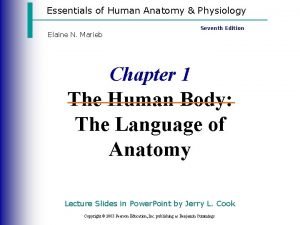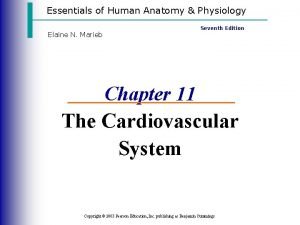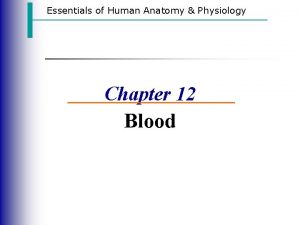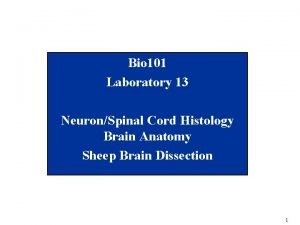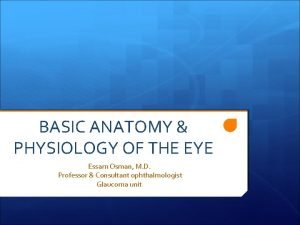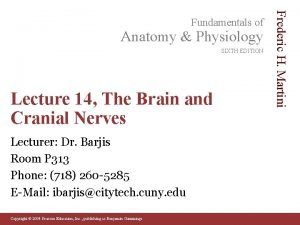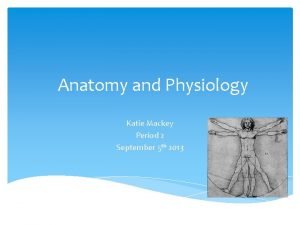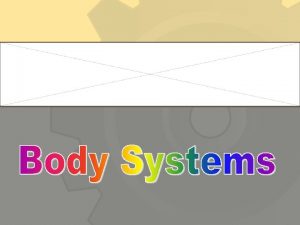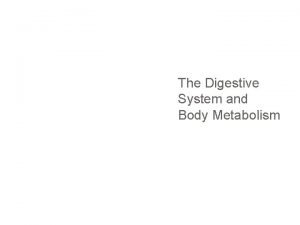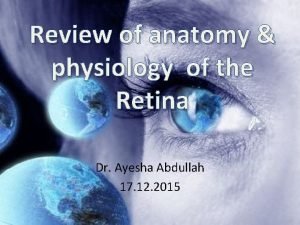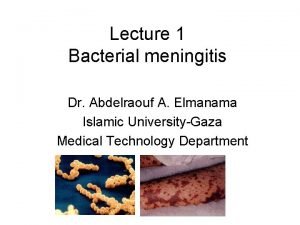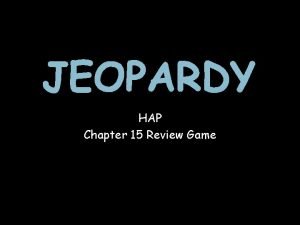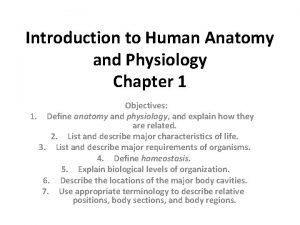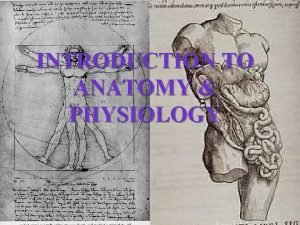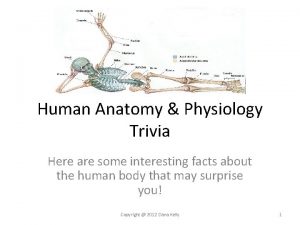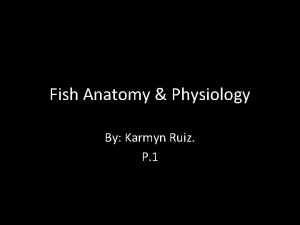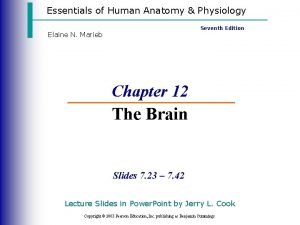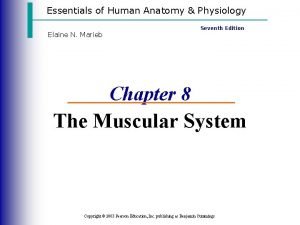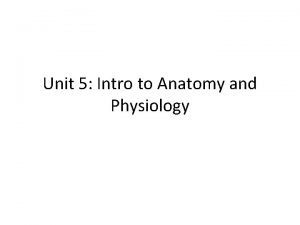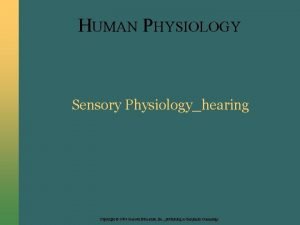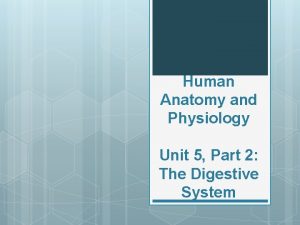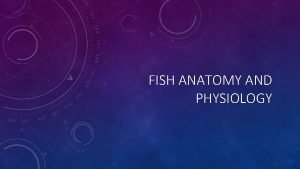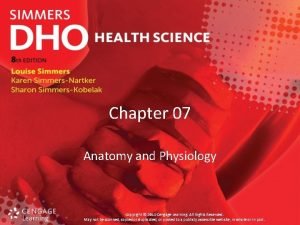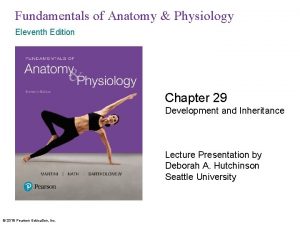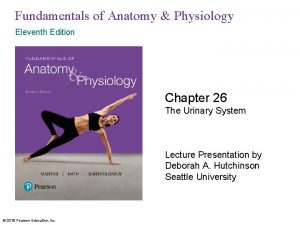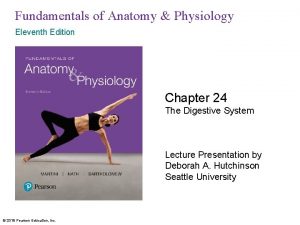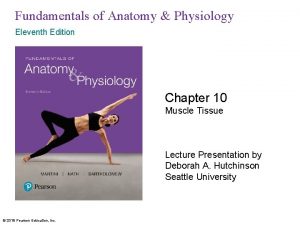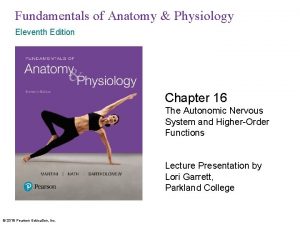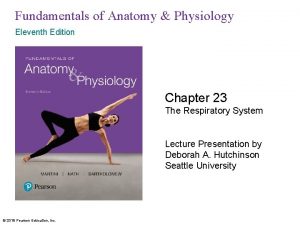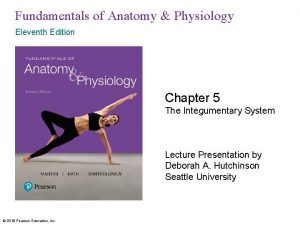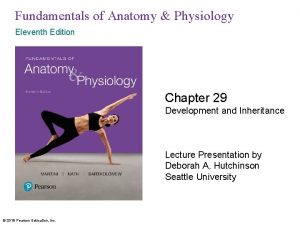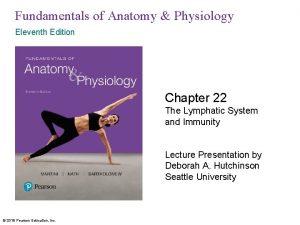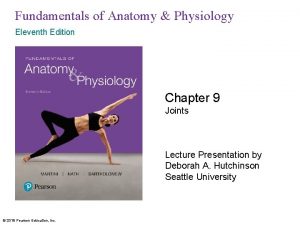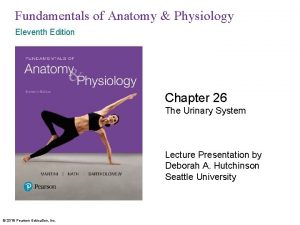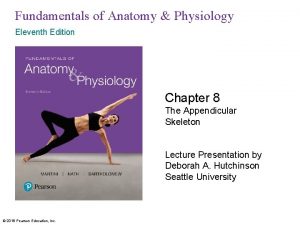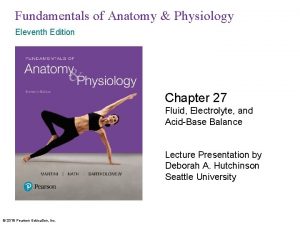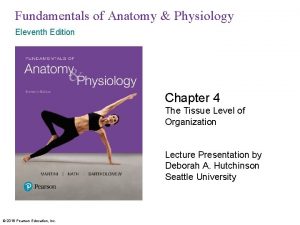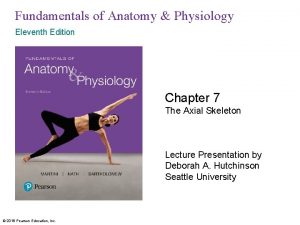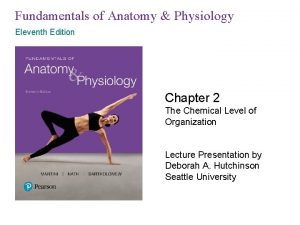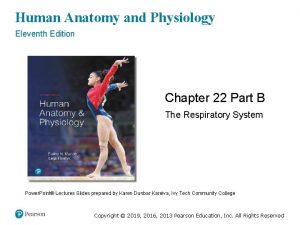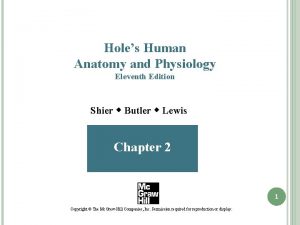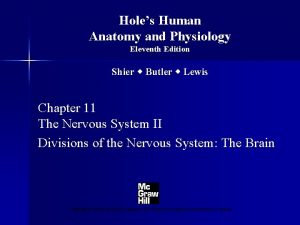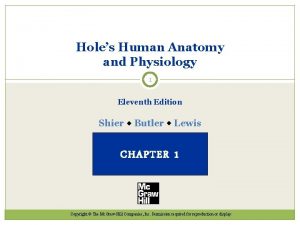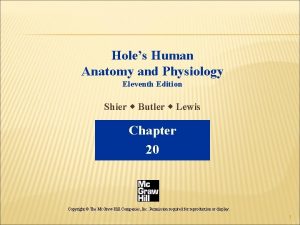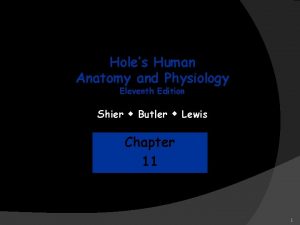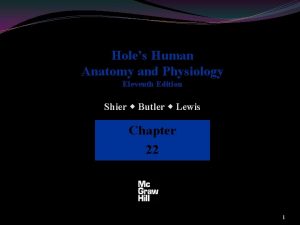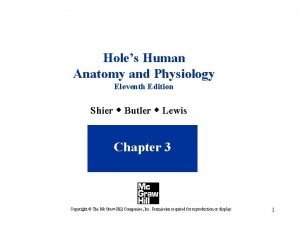Fundamentals of Anatomy Physiology Eleventh Edition Chapter 14


































































































- Slides: 98

Fundamentals of Anatomy & Physiology Eleventh Edition Chapter 14 The Brain and Cranial Nerves Lecture Presentation by Deborah A. Hutchinson Seattle University © 2018 Pearson Education, Inc.

Learning Outcomes 14 -1 Name the major brain regions, vesicles, and ventricles, and describe the locations and functions of each. 14 -2 Explain how the brain is protected and supported, and discuss the formation, circulation, and function of cerebrospinal fluid. 14 -3 Describe the anatomical differences between the medulla oblongata and the spinal cord, and identify the main components and functions of the medulla oblongata. 14 -4 List the main components of the pons, and specify the functions of each. 14 -5 List the main components of the midbrain, and specify the functions of each. 2 © 2018 Pearson Education, Inc.

Learning Outcomes 14 -6 List the main components of the cerebellum, and specify the functions of each. 14 -7 List the main components of the diencephalon, and specify the functions of each. 14 -8 Identify the main components of the limbic system, and specify the locations and functions of each. 14 -9 Identify the major anatomical subdivisions and functions of the cerebrum, and discuss the origin and significance of the major types of brain waves seen in an electroencephalogram. 14 -10 Describe representative examples of cranial reflexes that produce somatic responses or visceral responses to specific stimuli. 3 © 2018 Pearson Education, Inc.

Introduction to the Brain and Cranial Nerves § Adult human brain – Contains almost 97 percent of body’s nervous tissue – Average weight is 1. 4 kg (3 lb) – Volume is typically 1200 m. L • Ranges from 750 to 2100 m. L in functionally normal individuals – Brains of males are about 10 percent larger than those of females • No correlation between brain size and intelligence 4 © 2018 Pearson Education, Inc.

14 -1 The Brain § Regions of the brain – Cerebrum – Cerebellum – Diencephalon – Brainstem Left cerebral hemisphere Gyri a Cerebrum Sulci • Conscious thought processes, intellectual functions • Memory storage and processing • Conscious and subconscious regulation of skeletal muscle contractions Fissures b Cerebellum Spinal cord © 2018 Pearson Education, Inc. • Coordinates complex somatic motor patterns • Adjusts output of other somatic motor 5 and centers in brain spinal cord

14 -1 The Brain § Cerebrum – Largest part of adult brain – Controls higher mental functions • Conscious thoughts, intellect, memory, etc. – Divided into left and right cerebral hemispheres § Cerebral cortex of cerebrum – Surface layer of gray matter – Rounded elevations (gyri) increase surface area – Gyri are separated by • Shallow depressions (sulci) or • Deep grooves (fissures) 6 © 2018 Pearson Education, Inc.

14 -1 The Brain § Cerebellum – Second-largest part of brain – Coordinates repetitive body movements – Two hemispheres – Covered by gray matter (cerebellar cortex) 7 © 2018 Pearson Education, Inc.

14 -1 The Brain § Diencephalon – Located under cerebrum and cerebellum – Thalamus • Relays and processes sensory information – Hypothalamus is involved with • Emotions • Autonomic function • Hormone production – Pituitary gland • Major endocrine gland • Connected to hypothalamus via infundibulum (stalk) – Integrates nervous and endocrine systems 8 © 2018 Pearson Education, Inc.

14 -1 The Brain § Brainstem – Relays information between spinal cord and cerebrum or cerebellum – Includes • Midbrain • Pons • Medulla oblongata © 2018 Pearson Education, Inc. c Diencephalon Thalamus • Relays and processes sensory information Hypothalamus • Controls emotions, autonomic functions, and hormone production Brainstem d Midbrain • Processes visual and auditory data • Generates reflexive somatic motor responses • Maintains consciousness e Pons • Relays sensory information to cerebellum and thalamus • Subconscious somatic and visceral motor centers f Medulla oblongata • Relays sensory information to thalamus and to other portions of the brainstem • Autonomic centers for regulation of visceral function (cardiovascular, respiratory, and digestive system activities) 9

14 -1 The Brain § Midbrain – Processes sight, sound, and associated reflexes – Maintains consciousness § Pons – Connects cerebellum to brainstem – Contains • Tracts (collections of CNS axons) • Relay centers • Nuclei for somatic and visceral motor control § Medulla oblongata – – Connects brain to spinal cord Inferior portion has a narrow central canal Relays sensory information Regulates autonomic functions • Heart rate, blood pressure, and digestion © 2018 Pearson Education, Inc. 10

14 -1 The Brain § Ventricles of the brain – Each cerebral hemisphere contains one large lateral ventricle • Separated by medial partition (septum pellucidum) – Third ventricle in diencephalon • Communicates with each lateral ventricle • Via interventricular foramen – Fourth ventricle • Extends into medulla oblongata • Joins central canal of spinal cord • Connects with third ventricle – Via narrow canal in midbrain (cerebral aqueduct) 11 © 2018 Pearson Education, Inc.

Figure 14– 2 a Ventricular System. Cerebral hemispheres Ventricular System of the Brain Lateral ventricles Interventricular foramen Third ventricle Cerebral aqueduct Fourth ventricle Pons Medulla oblongata Spinal cord Central canal a Ventricular system, lateral view 12

Figure 14– 2 b Ventricular System of the Brain Cerebral hemispheres Lateral ventricles Interventricular foramen Third ventricle Cerebral aqueduct Fourth ventricle Central canal Cerebellum b Ventricular system, anterior view 13

14 -2 Brain Protection and Support § Physical protection of the brain – Bones of the cranium – Cranial meninges – Cerebrospinal fluid § Biochemical isolation – Blood brain barrier § Cranial meninges - Have three layers • Dura mater • Arachnoid mater • Pia mater – Continuous with spinal meninges – Dura mater • Inner fibrous layer (meningeal cranial dura) • Outer fibrous layer (periosteal cranial dura) – Fused to periosteum © 2018 Pearson Education, Inc. 14

14 -2 Brain Protection and Support § Cranial meninges – Arachnoid mater • Covers brain • In life, it attaches to dura mater – May be separated by subdural space • Subarachnoid space lies between arachnoid mater and pia mater – Pia mater • Attached to brain surface by astrocytes 15 © 2018 Pearson Education, Inc.

Figure 14– 3 a The Relationships among the Brain, Cranium, and Cranial Meninges. Cranium Dura mater Subarachnoid space Pia mater Cerebral cortex Periosteal cranial dura Dural sinus Meningeal cranial dura Subdural space Arachnoid mater Cerebrum Cerebellum Medulla oblongata Spinal cord a A lateral view of the brain, showing its position in the cranium and the organization of the meninges 16

14 -2 Brain Protection and Support § Cerebrospinal fluid (CSF) – Surrounds all exposed surfaces of CNS – Functions to • Support brain • Cushion delicate neural structures • Transport nutrients, chemical messengers, and wastes § Choroid plexus produces CSF – Specialized ependymal cells surround capillaries – Secretes about 500 m. L of CSF into ventricles per day – Removes waste products from CSF – Adjusts composition of CSF 17 © 2018 Pearson Education, Inc.

14 -2 Brain Protection and Support § CSF circulates – From choroid plexus – Through ventricles – To central canal of spinal cord – Into subarachnoid space • Via two lateral apertures and one median aperture in roof of fourth ventricle • To surround brain, spinal cord, and cauda equina 18 © 2018 Pearson Education, Inc.

14 -2 Brain Protection and Support § Arachnoid villi – Extensions of arachnoid membrane – Extend through meningeal layer of dura mater into superior sagittal sinus § Arachnoid granulations – Large clusters of arachnoid villi in adults – Absorb CSF into venous circulation 19 © 2018 Pearson Education, Inc.

Figure 14– 4 Formation and Circulation of Cerebrospinal Fluid (Part 2 of 3). Choroid plexus of third ventricle 2 The CSF circulates from the choroid plexus through the ventricles and fills the central canal of the spinal cord. As it circulates, materials diffuse between the CSF and the interstitial fluid of the CNS across the ependymal cells. Choroid plexus of fourth ventricle 3 Spinal cord Central canal Dura mater Conus medullaris Arachnoid mater Cauda equina The CSF reaches the subarachnoid space through two lateral apertures and a single median aperture in the roof of the fourth ventricle. 4 Cerebrospinal fluid then flows through the subarachnoid space surrounding the brain, spinal cord, and cauda equina. Filum terminale 20

14 -2 Brain Protection and Support § Protective function of cranial meninges and CSF – Dural folds hold brain in position • Protect it from damage that would result from contact with cranium – CSF cushions brain against sudden jolts – Cranial trauma • Head injury resulting from impact with an object 21 © 2018 Pearson Education, Inc.

14 -2 Brain Protection and Support § Blood supply to the brain – Internal carotid arteries and vertebral arteries • Deliver nutrients and oxygen – Most blood is removed from dural venous sinuses by internal jugular veins § Cerebrovascular diseases – Disorders that interfere with blood supply to brain – Cerebrovascular accident (CVA) or stroke • Stops blood flow to a portion of the brain • Affected neurons begin to die within minutes 22 © 2018 Pearson Education, Inc.

14 -2 Brain Protection and Support § Blood brain barrier (BBB) – Isolates CNS from general circulation – Formed by network of tight junctions • Between capillary endothelial cells in CNS – Generally, only lipid-soluble compounds like O 2, CO 2, steroids, prostaglandins, and small alcohols • Can diffuse into interstitial fluid of CNS – Astrocytes regulate blood brain barrier by • Releasing chemicals that control permeability of endothelium 23 © 2018 Pearson Education, Inc.

14 -2 Brain Protection and Support § Blood CSF barrier – Formed by specialized ependymal cells connected by tight junctions • That surround capillaries of choroid plexus – Limits transfer of substances to CSF – Allows chemical composition of blood and CSF to differ 24 © 2018 Pearson Education, Inc.

14 -2 Brain Protection and Support § Breaks in the BBB – Portions of hypothalamus • Allows hypothalamic hormones into circulation – Posterior lobe of pituitary gland • Allows ADH and oxytocin into circulation – Pineal gland • Allows pineal secretions into circulation – Choroid plexus • Where specialized ependymal cells maintain blood CSF barrier 25 © 2018 Pearson Education, Inc.

14 -3 The Medulla Oblongata § Medulla oblongata – Most inferior part of brainstem – Coordinates complex autonomic reflexes – Includes three groups of nuclei • Control visceral functions • Sensory and motor nuclei of CNS • Relay stations for communication between brain and spinal cord 26 © 2018 Pearson Education, Inc.

14 -3 The Medulla Oblongata § Reflex centers: autonomic and reflex activity – Reticular formation • Gray and white matter with embedded nuclei • Regulates autonomic functions – Cardiovascular centers • Cardiac and vasomotor centers • Control blood flow through peripheral tissues – Respiratory rhythmicity centers • Set pace for respiratory movements § Sensory and motor nuclei of cranial nerves – Associated with 5 cranial nerves (VIII, IX, X, XII) 27 © 2018 Pearson Education, Inc.

Figure 14– 5 a The Diencephalon and Brainstem. Diencephalon Cerebral peduncle Lateral geniculate nucleus Thalamus Optic tract Medial geniculate nucleus Cranial Nerves Midbrain II Superior colliculus Inferior colliculus III IV Cerebellar Peduncles Superior cerebellar peduncle V Pons VI VIII IX X XI Middle cerebellar peduncle Inferior cerebellar peduncle Medulla oblongata XII Spinal nerve C 1 Spinal nerve C 2 Spinal cord a Lateral view 28

Figure 14– 5 b The Diencephalon and Brainstem. Optic chiasm Thalamus Infundibulum Cranial Nerves II Optic tract III Cerebral peduncle IV Mammillary body Pons V VI VIII IX X XI XII Medulla oblongata Ventral roots of spinal nerves C 1 and C 2 Spinal cord b Anterior view 29

14 -4 The Pons § Pons contains – Sensory and motor nuclei of cranial nerves – Nuclei involved with respiration • Apneustic center and pneumotaxic center – Nuclei and tracts that process and relay information sent to or from cerebellum – Ascending, descending, and transverse pontine fibers • Transverse pontine fibers (axons) link nuclei of pons with opposite cerebellar hemisphere 30 © 2018 Pearson Education, Inc.

Figure 14– 7 The Pons Cerebellum Fourth ventricle Medulla oblongata Spinal cord Inferior olivary nucleus 31

14 -5 The Midbrain § Structures of the midbrain – Tectum • Two pairs of sensory nuclei (corpora quadrigemina) – Superior colliculi (visual) – Inferior colliculi (auditory) – Tegmentum • Red nucleus (many blood vessels) • Substantia nigra (pigmented gray matter) – Cerebral peduncles • Nerve fiber bundles on ventrolateral surfaces • Contain – Descending fibers to cerebellum – Descending motor command fibers © 2018 Pearson Education, Inc. 32

Figure 14– 8 a The Midbrain. Pineal gland Thalamus a A posterior view. The underlying nuclei are colored only on the right. 33

14 -6 The Cerebellum § Structures of the cerebellum – Cerebellar cortex • Gray matter of highly convoluted surface – Folia • Folds in cerebellar cortex – Anterior and posterior lobes • Separated by primary fissure – Cerebellar hemispheres – Vermis (“worm”) • Narrow band of cortex • Separates cerebellar hemispheres at midline – Flocculonodular lobe • Lies above roof of fourth ventricle 34 © 2018 Pearson Education, Inc.

14 -6 The Cerebellum § Structures of the cerebellum – Purkinje cell layer • Consists of large, branched neuron cell bodies • In cerebellar cortex • Each cell receives input from up to 200, 000 synapses – Arbor vitae (“tree of life”) • Highly branched, internal white matter of cerebellum • Cerebellar nuclei embedded in arbor vitae – Relay information to Purkinje cells § Functions of the cerebellum are to – Adjust postural muscles – Program and fine-tune conscious and subconscious movements 35 © 2018 Pearson Education, Inc.

14 -6 The Cerebellum § Cerebellar peduncles – Tracts that link cerebellum with brainstem, cerebrum, and spinal cord leave the cerebellum as • Superior cerebellar peduncles • Middle cerebellar peduncles • Inferior cerebellar peduncles § Disorders of the cerebellum – Ataxia • Disturbance in muscular coordination • Caused by – Damage from trauma or stroke – Intoxication (temporary impairment) 36 © 2018 Pearson Education, Inc.

Figure 14– 9 a The Cerebellum (Part 1 of 2). Vermis Anterior lobe Primary fissure Folia Posterior lobe Left Hemisphere of Cerebellum Right Hemisphere of Cerebellum a The posterior, superior surface of the cerebellum, showing major anatomical landmarks and regions 37

Figure 14– 9 b The Cerebellum (Part 1 of 2). Anterior lobe Midbrain Choroid plexus of the fourth ventricle Flocculonodular lobe Pons Medulla oblongata Posterior lobe b A sectional view of the cerebellum, showing the arrangement of gray matter and white matter 38

14 -7 The Diencephalon § Diencephalon – Integrates sensory information with motor commands – Epithalamus, and hypothalamus – Pineal gland • In posterior portion of epithalamus • Secretes melatonin 39 © 2018 Pearson Education, Inc.

14 -7 The Diencephalon § Thalamus – Filters and relays sensory information • From spinal cord and cranial nerves • To cerebral cortex – Relays information between basal nuclei and cerebral cortex – The third ventricle separates left and right sides – Interthalamic adhesion • Projection of gray matter • Extends into third ventricle on each side § Thalamic nuclei – Relay sensory information to basal nuclei and cerebral cortex 40 © 2018 Pearson Education, Inc.

Table 14– 2 The Thalamus 41

Figure 14– 10 b The Thalamus. Limbic system Frontal lobes Anterior nuclei Association areas of cerebral cortex Parietal lobe and cingulate gyrus Medial nuclei Lateral nuclei Pulvinar V e n t r a l n u c l e i Auditory input Medial geniculate body Basal nuclei Cerebellum General sensory input Visual input Lateral geniculate body b An enlarged view of the thalamic nuclei of the left side 42

14 -7 The Diencephalon § Hypothalamus – Mammillary bodies • Control reflex eating movements – Infundibulum • A narrow stalk • Connects hypothalamus to pituitary gland – Tuber cinereum • Between infundibulum and mammillary bodies • Produces hormones that affect pituitary gland 43 © 2018 Pearson Education, Inc.

Figure 14– 11 a The Hypothalamus in Sagittal Section. Parietal lobe Corpus callosum Choroid plexus Septum pellucidum Thalamus (surrounds third ventricle) Fornix Anterior cerebral artery Frontal lobe Pineal gland Hypothalamus Cerebral aqueduct Anterior commissure Cerebellum Optic chiasm Optic nerve Fourth ventricle Infundibulum (cut) Tuber cinereum Mammillary body a The hypothalamus and adjacent portions of the brain 44

Figure 14– 11 b The Hypothalamus in Sagittal Section. Interthalamic adhesion Thalamus Tuber cinereum Hypothalamus Optic chiasm Infundibulum Pituitary gland Midbrain Pons b A diagram of the hypothalamus, showing the locations and functions of major nuclei and centers 45

14 -7 The Diencephalon § Eight functions of hypothalamus 1. Secretes ADH (supra-optic nucleus) and oxytocin 2. 3. 4. 5. 6. 7. 8. (paraventricular nucleus) Regulates body temperature (Pre-optic area Controls autonomic function Coordinates voluntary and autonomic functions Coordinates nervous and endocrine systems Regulates circadian rhythms (day–night cycles) • Suprachiasmatic nucleus Subconscious control of skeletal muscle Produces emotions and behavioral drives • Feeding center (hunger) • Thirst center (thirst) • Satiety center (regulates food intake) 46 © 2018 Pearson Education, Inc.

14 -8 The Limbic System § Limbic system – Functional grouping that • Establishes emotional states • Links conscious functions of cerebral cortex with autonomic functions of brainstem • Facilitates memory storage and retrieval § Components of the limbic system – Limbic lobe of cerebral hemisphere • • Cingulate gyrus Dentate gyrus Parahippocampal gyrus Hippocampus – Amygdaloid body • Acts as interface between the limbic system, cerebrum, and various sensory systems 47 © 2018 Pearson Education, Inc.

14 -8 The Limbic System § Components of the limbic system – Fornix • Tract of white matter • Connects hippocampus with hypothalamus – Anterior nuclei of thalamus • Relay information from mammillary body to cingulate gyrus – Reticular formation • Alertness, excitement, lethargy, and sleep 48 © 2018 Pearson Education, Inc.

Figure 14– 12 a The Limbic System. Corpus callosum Fornix Pineal gland Cingulate gyrus (superior portion of limbic lobe) Anterior thalamic nuclei Parahippocampal gyrus (inferior portion of limbic lobe) Hypothalamus Mammillary body Temporal lobe of cerebrum Hippocampus (within dentate gyrus, the posterior portion of limbic lobe) a A diagrammatic sagittal section through the cerebrum, showing the cortical areas associated with the limbic system. The parahippocampal gyrus is shown as though transparent to make deeper limbic components visible. 49

14 -9 The Cerebrum § Cerebrum – Largest part of brain – Controls all conscious thoughts and intellectual functions – Processes somatic sensory and motor information – Gray matter • In cerebral cortex and basal nuclei – White matter • Deep to cerebral cortex • Around basal nuclei 50 © 2018 Pearson Education, Inc.

14 -9 The Cerebrum § Structures of the cerebrum – Gyri of cerebral cortex • Increase surface area available for cortical neurons – Longitudinal cerebral fissure • Separates cerebral hemispheres – Lobes • Regions of hemispheres – Central sulcus divides • Anterior frontal lobe from posterior parietal lobe – Precentral gyrus of frontal lobe • Forms anterior border of central sulcus – Postcentral gyrus of parietal lobe • Forms posterior border of central sulcus 51 © 2018 Pearson Education, Inc.

14 -9 The Cerebrum § Structures of the cerebrum – Lateral sulcus • Separates frontal lobe from temporal lobe – Insula (“island” of cortex) • Lies medial to lateral sulcus – Parieto-occipital sulcus • Separates parietal lobe from occipital lobe Insula c Retractors along the lateral sulcus showing the insula 52 © 2018 Pearson Education, Inc.

Figure 14– 13 b The Brain in Lateral View. Precentral gyrus Central Postcentral gyrus sulcus Frontal lobe Parietal lobe Occipital lobe Temporal lobe Lateral sulcus Cerebellum Pons Medulla oblongata b Lateral view 53

Figure 14– 13 d The Brain in Lateral View. Precentral gyrus Central sulcus Postcentral gyrus Cingulate gyrus Parietal lobe Frontal lobe Parietooccipital sulcus Occipital lobe Pons Temporal lobe Cerebellum Medulla oblongata d Midsagittal section 54

14 -9 The Cerebrum § White matter of the cerebrum – Association fibers • Form connections within one hemisphere • Arcuate fibers – Short fibers – Connect one gyrus to another • Longitudinal fasciculi – Longer bundles – Connect frontal lobe to other lobes in same hemisphere 55 © 2018 Pearson Education, Inc.

14 -9 The Cerebrum § White matter of the cerebrum – Commissural fibers • Bands of fibers connecting two hemispheres • Corpus callosum • Anterior commissure § White matter of the cerebrum – Projection fibers • Link cerebral cortex to diencephalon, brainstem, cerebellum, and spinal cord • Pass through diencephalon • Internal capsule – All ascending and descending projection fibers 56 © 2018 Pearson Education, Inc.

Figure 14– 14 a Fibers of the White Matter of the Cerebrum. a Lateral view Longitudinal cerebral fissure Internal capsule b Anterior view 57

14 -9 The Cerebrum § Basal nuclei – Masses of gray matter – Embedded in white matter of cerebrum – Direct subconscious activities § Functions of basal nuclei – Subconscious control of skeletal muscle tone – Coordination of learned movement patterns (walking, lifting) § Parkinson’s disease – Symptoms are caused by increased activity of basal nuclei 58 © 2018 Pearson Education, Inc.

14 -9 The Cerebrum § Functional principles of the cerebrum – Cortex of each cerebral hemisphere • Receives somatosensory information from • And sends motor commands to • The opposite side of the body – Correspondence between a specific function and a specific area of the cerebral cortex is imprecise § Central sulcus separates motor and sensory areas § Motor areas – Primary motor cortex • Surface of precentral gyrus – Pyramidal cells • Neurons of primary motor cortex © 2018 Pearson Education, Inc. 59

14 -9 The Cerebrum § Sensory areas – Primary somatosensory cortex • Surface of postcentral gyrus § Special sensory cortices – Visual cortex • Receives visual information – Auditory cortex • Receives information about hearing – Olfactory cortex • Receives information about smell – Gustatory cortex • Receives information from taste receptors 60 © 2018 Pearson Education, Inc.

14 -9 The Cerebrum § Association areas – Connected to sensory and motor regions of cortex – Interpret incoming data or coordinate a motor response § Premotor cortex – Also called somatic motor association area – Coordinates learned movements § Sensory association areas – Somatosensory association cortex • Monitors activity in primary somatosensory cortex • Example: it recognizes touch – Visual association area • Interprets activity in visual cortex – Auditory association area • Monitors auditory cortex © 2018 Pearson Education, Inc. 61

Figure 14– 16 a Motor, Sensory, and Association Areas of the Cerebral Cortex. Parietal Lobe Central sulcus Frontal Lobe Primary somatosensory cortex Primary motor cortex Premotor cortex Somatosensory association cortex Retractor Occipital Lobe Visual association area Visual cortex Prefrontal cortex Gustatory cortex Insula Lateral sulcus Temporal Lobe Auditory association area Auditory cortex Olfactory cortex a Major anatomical landmarks on the surface of the left cerebral hemisphere. The lateral sulcus has been pulled apart to expose the insula. 62

Table 14– 3 The Cerebral Cortex 63

14 -9 The Cerebrum § Integrative centers – In lobes and cortical areas of both cerebral hemispheres – Receive information from association areas – Direct complex motor activities – Perform analytical functions § Wernicke’s area – Language comprehension – Primarily associated with left cerebral hemisphere – Receives information from sensory association areas – Coordinates access to visual and auditory memories § Broca’s area (motor speech area) – Speech production – Primarily associated with left cerebral hemisphere – Regulates patterns of breathing and vocalization © 2018 Pearson Education, Inc. 64

14 -9 The Cerebrum § Prefrontal cortex of frontal lobe – Coordinates information relayed from all cortical association areas – Performs abstract intellectual functions • Example: predicting consequences of actions – Prefrontal lobotomy • Used to “cure” mental illnesses in mid-20 th century 65 © 2018 Pearson Education, Inc.

Figure 14– 16 b Motor, Sensory, and Association Areas of the Cerebral Cortex. Frontal eye field Broca’s area Wernicke’s area Prefrontal cortex b The left hemisphere generally contains the specialized language areas. The prefrontal cortex of each hemisphere is involved with conscious intellectual functions. 66

14 -9 The Cerebrum § Hemispheric lateralization – Functional differences between left and right cerebral hemispheres • Each performs certain functions that are not ordinarily performed by the opposite hemisphere § Left cerebral hemisphere – Reading, writing, and math – Speech and language – Decision making § Right cerebral hemisphere – Analyzes sensory information • Example: touch, smell, sight, taste – Recognition of faces and voice inflections 67 © 2018 Pearson Education, Inc.

14 -9 The Cerebrum § Brain activity – Assessed with an electroencephalogram (EEG) • Electrodes are placed on brain or skull • Electrical patterns (brain waves) are observed § Types of typical brain waves – Alpha waves – Beta waves – Theta waves – Delta waves 68 © 2018 Pearson Education, Inc.

Figure 14– 17 a Brain Waves. • Alpha waves • Seen in healthy, awake adults at rest with eyes closed a Alpha waves are characteristic of normal resting adults 0 Seconds 1 2 3 4 69

Figure 14– 17 b Brain Waves. § Beta waves – Higher-frequency waves – Seen in adults who are concentrating or mentally stressed b Beta waves typically accompany intense concentration 0 Seconds 1 2 3 4 70

Figure 14– 17 c Brain Waves. § Theta waves – Seen in children and in intensely frustrated adults – May indicate brain disorder in adults c Theta waves are seen in children and in frustrated adults 0 Seconds 1 2 3 4 71

Figure 14– 17 d Brain Waves. § Delta waves – Large-amplitude, low-frequency waves – Occur during sleep, in infants, and in awake adults with brain damage d Delta waves occur in deep sleep and in certain pathological conditions 0 Seconds 1 2 3 4 72

14 -9 The Cerebrum § Synchronization of electrical activity between hemispheres – Achieved through a “pacemaker” mechanism – Desynchronization may result from injury or tumor § Seizure – A temporary cerebral disorder – Accompanied by changes in electrical activity – Symptoms depend on region of cortex affected 73 © 2018 Pearson Education, Inc.

14 -10 Cranial Nerves § Cranial nerves – 12 pairs connected to brain § Classifications of cranial nerves – Primarily sensory: carriers of somatic sensory information including touch, pressure, vibration, temperature, and pain – Special sensory: carriers of sensations such as smell, sight, hearing, and balance – Motor: axons of somatic motor neurons – Mixed: sensory and motor fibers 74 © 2018 Pearson Education, Inc.

14 -10 Cranial Nerves § Cranial nerves – Are classified by primary functions – May also have important secondary functions – Several distribute autonomic fibers to peripheral ganglia Cranial Nerves Olfactory bulb: termination of olfactory nerve (I) Optic nerve (II) Oculomotor nerve (III) Trochlear nerve (IV) Trigeminal nerve (V) Abducens nerve (VI) Facial nerve (VII) Vestibulocochlear nerve (VIII) Glossopharyngeal nerve (IX) Vagus nerve (X) Hypoglossal nerve (XII) Accessory nerve (XI) 75 © 2018 Pearson Education, Inc.

14 -10 Cranial Nerves § Olfactory nerves (I) – Primary function - Special sensory (smell) – Origin - Receptors of olfactory epithelium – Pass through olfactory foramina in cribriform plate of ethmoid – Destination - Olfactory bulbs § Olfactory nerve structures – Olfactory bulbs • Located on either side of crista galli – Olfactory tracts • Axons of postsynaptic neurons • Leading to cerebrum 76 © 2018 Pearson Education, Inc.

Figure 14– 19 The Olfactory Nerve. Olfactory tract (to olfactory cortex of cerebrum) Left olfactory bulb (termination of olfactory nerve) Olfactory nerve (I) Olfactory nerve fibers Cribriform plate Olfactory of ethmoid epithelium 77

14 -10 Cranial Nerves § Optic nerves (II) – Primary function - Special sensory (vision) – Origin - Retina of eye – Pass through optic canals of sphenoid – Destination - Diencephalon via optic chiasm § Optic nerve structures – Optic chiasm • Where optic nerves converge • At ventral, anterior margin of diencephalon • Some fibers cross to opposite side of brain – Optic tracts • Reorganized axons • Continue to lateral geniculate body of thalamus 78 © 2018 Pearson Education, Inc.

Figure 14– 20 The Optic Nerve. Eye Pituitary gland Olfactory bulb Olfactory tract Optic nerve (II) Optic chiasm Optic tract Lateral geniculate body (in thalamus) Midbrain (cut) Visual cortex (in occipital lobes) Optic projection fibers 79

14 -10 Cranial Nerves § Oculomotor nerves (III) – Primary function - Motor (eye movements) – Origin - Midbrain – Pass through Superior orbital fissures of sphenoid – Destination Somatic motor – Superior, inferior, and medial rectus muscles – Inferior oblique – Levator palpebrae superioris • Visceral motor – Intrinsic eye muscles – Each controls four of six eye-movement muscles – Deliver autonomic fibers to neurons of ciliary ganglion • These neurons control intrinsic eye muscles © 2018 Pearson Education, Inc. 80

14 -10 Cranial Nerves § Trochlear nerves (IV) – Primary function - Motor (eye movements) – Origin - Midbrain – Pass through Superior orbital fissures of sphenoid – Destination - Superior oblique § Abducens nerves (VI) – Primary function - Motor (eye movements) – Origin - Pons – Pass through Superior orbital fissures of sphenoid – Destination - Lateral rectus 81 © 2018 Pearson Education, Inc.

Figure 14– 21 Cranial Nerves Controlling the Extrinsic Eye Muscles. Superior rectus Superior oblique Optic nerve (II) Optic chiasm Oculomotor nerve (III) Trochlear nerve (IV) Trochlea Levator palpebrae superioris Trigeminal nerve (V), cut Inferior oblique Vestibulocochlear nerve (VIII), cut Inferior Ciliary rectus ganglion Medial rectus Lateral rectus (cut) Abducens nerve (VI) Facial nerve (VII), cut 82

14 -10 Cranial Nerves § Trigeminal nerves (V) – Primary function - Mixed (sensory and motor) of face – Origin - Ophthalmic nerve (V 1) (sensory) – Orbital structures – Nasal cavity – Skin of forehead, upper eyelid, and eyebrow – Part of nose – Origin - Maxillary nerve (V 2) (sensory) – Lower eyelid – Upper lip, gums, and teeth – Cheek and nose – Palate and part of pharynx 83 © 2018 Pearson Education, Inc.

14 -10 Cranial Nerves § Trigeminal nerves (V) – Origin • Mandibular nerve (V 3) (sensory) – Lower gums, teeth, and lips – Palate and part of tongue • Mandibular nerve (V 3) (motor) – Motor nuclei of pons – Largest cranial nerves 84 © 2018 Pearson Education, Inc.

Figure 14– 22 The Trigeminal Nerve. Superior orbital fissure Ophthalmic nerve (V 1) Supra-orbital nerves Ciliary ganglion Foramen rotundum Infra-orbital nerve Semilunar ganglion Pons Trigeminal nerve (V) Maxillary nerve (V 2) Foramen ovale Lingual nerve Submandibular ganglion Mental nerve Otic ganglion Mandibular nerve (V 3) Pterygopalatine ganglion 85

14 -10 Cranial Nerves § Facial nerves (VII) – Primary function - Mixed (sensory and motor) of face – Origin • Sensory - Taste receptors on anterior two-thirds of tongue • Motor - Motor nuclei of pons – Destination • Sensory - Sensory nuclei of pons • Somatic motor - Muscles of facial expression • Visceral motor – Lacrimal gland nasal mucous glands – Submandibular and sublingual glands 86 © 2018 Pearson Education, Inc.

14 -10 Cranial Nerves § Bell’s palsy – Cranial nerve disorder resulting from inflammation of facial nerve – Likely due to viral infection – Signs and symptoms • Paralysis of facial muscles on affected side • Loss of taste sensations from anterior two-thirds of tongue – Typically, symptoms fade after weeks or months 87 © 2018 Pearson Education, Inc.

Figure 14– 23 a The Facial Nerve. Pterygopalatine Greater petrosal Geniculate ganglion nerve ganglion Facial nerve (VII) Temporal branch Pons Posterior auricular nerve Zygomatic branches Buccal branch Stylomastoid foramen Chorda tympani with mandibular nerve Marginal mandibular branch Lingual branch with lingual nerve Cervical branch Submandibular ganglion a The origin and branches of the facial nerve 88

14 -10 Cranial Nerves § Vestibulocochlear nerves (VIII) – Primary function - Special sensory – Vestibular nerve - Balance and equilibrium – Cochlear nerve - Hearing – Origin - Receptors of internal ear – Pass through Internal acoustic meatus of temporal bones – Destination - Vestibular and cochlear nuclei of pons and medulla oblongata 89 © 2018 Pearson Education, Inc.

Figure 14– 24 The Vestibulocochlear Nerve. Tympanic cavity (middle ear) Semicircular canals Vestibular nerve Facial nerve Internal Vestibulocochlear (VII), cut acoustic meatus nerve (VIII) CN V Pons CN VII Medulla oblongata Tympanic membrane Auditory tube Cochlea CN IX CN XII CN XI Cochlear nerve 90

14 -10 Cranial Nerves § Glossopharyngeal nerves (IX) – Primary function - Mixed (sensory and motor) of head and neck – Origin • Sensory – Posterior one-third of tongue – Part of pharynx and palate – Carotid arteries • Motor – Motor nuclei of medulla oblongata 91 © 2018 Pearson Education, Inc.

Figure 14– 25 The Glossopharyngeal Nerve. Pons CN VII CN VI Otic ganglion Inferior (petrosal) ganglion CN VIII Glossopharyngeal nerve (IX) Medulla oblongata Superior (jugular) ganglion Pharyngeal branches Lingual branch Parotid gland Carotid branch Carotid body Carotid sinus Common carotid artery 92

14 -10 Cranial Nerves § Vagus nerves (X) – Primary function • Mixed (sensory and motor) • Widely distributed in thorax and abdomen – Origin • Sensory – Part of pharynx – Auricle and external acoustic meatus – Diaphragm – Visceral organs in thoracic and abdominopelvic cavities • Motor – Motor nuclei in medulla oblongata 93 © 2018 Pearson Education, Inc.

Figure 14– 26 The Vagus Nerve (Part 1 of 2). Pharyngeal branch Vagus nerve (X) Pons Medulla oblongata Auricular branch to external ear Inferior ganglion of vagus nerve Superior laryngeal nerve Superior ganglion of vagus nerve Pharyngeal branch Superior laryngeal nerve Internal branch External branch 94

Figure 14– 26 The Vagus Nerve (Part 2 of 2). Recurrent laryngeal nerve Cardiac branches Cardiac plexus Left lung Right lung Liver Anterior vagal trunk Spleen Stomach Celiac plexus Pancreas Colon Small intestine Hypogastric plexus 95

14 -10 Cranial Nerves § Accessory nerves (XI) – Primary function - Motor to muscles of neck and upper back – Origin - Motor nuclei of spinal cord and medulla oblongata – Pass through Jugular foramina between occipital bone and temporal bones – Destination • Internal branch – Voluntary muscles of palate, pharynx, and larynx • External branch – Sternocleidomastoid and trapezius 96 © 2018 Pearson Education, Inc.

14 -10 Cranial Nerves § Hypoglossal nerves (XII) – Primary function • Motor (tongue movements) – Origin • Motor nuclei of medulla oblongata – Pass through • Hypoglossal canals of occipital bone – Destination • Muscles of tongue 97 © 2018 Pearson Education, Inc.

Figure 14– 27 The Accessory and Hypoglossal Nerves. Hypoglossal nerve (XII) Accessory nerve (XI) Internal branch: to palatal, pharyngeal, and laryngeal muscles with vagus nerve Trigeminal nerve (V) Medulla oblongata Cranial root of CN XI Spinal root of CN XI Intrinsic muscles of tongue Styloglossus External branch of CN XI Genioglossus Geniohyoid Hyoglossus Spinal cord Hyoid bone Thyrohyoid Trapezius Sternocleidomastoid Sternohyoid Sternothyroid Ansa cervicalis (cervical plexus) Omohyoid 98
 Management eleventh edition stephen p robbins
Management eleventh edition stephen p robbins Management eleventh edition
Management eleventh edition Management eleventh edition
Management eleventh edition Management eleventh edition stephen p robbins
Management eleventh edition stephen p robbins Endomysium
Endomysium Human anatomy & physiology edition 9
Human anatomy & physiology edition 9 Uterus perimetrium
Uterus perimetrium The central sulcus divides which two lobes? (figure 14-13)
The central sulcus divides which two lobes? (figure 14-13) Waistline
Waistline Anatomy and physiology chapter 8 special senses
Anatomy and physiology chapter 8 special senses Chapter 13 anatomy and physiology of pregnancy
Chapter 13 anatomy and physiology of pregnancy Anatomy and physiology chapter 2
Anatomy and physiology chapter 2 Anatomy and physiology chapter 7
Anatomy and physiology chapter 7 Anatomy and physiology coloring workbook chapter 14
Anatomy and physiology coloring workbook chapter 14 Chapter 10 blood anatomy and physiology
Chapter 10 blood anatomy and physiology Anatomy and physiology chapter 15
Anatomy and physiology chapter 15 Necessary life functions anatomy and physiology
Necessary life functions anatomy and physiology Holes anatomy and physiology chapter 1
Holes anatomy and physiology chapter 1 Anatomy and physiology chapter 15
Anatomy and physiology chapter 15 Medial and lateral
Medial and lateral Chapter 2 human reproductive anatomy and physiology
Chapter 2 human reproductive anatomy and physiology Appendicular skeleton pectoral girdle
Appendicular skeleton pectoral girdle Chapter 6 general anatomy and physiology
Chapter 6 general anatomy and physiology Cranial cephalic
Cranial cephalic Chadha committee
Chadha committee Eleventh 5 year plan
Eleventh 5 year plan 11th five year plan
11th five year plan For his eleventh birthday elvis presley
For his eleventh birthday elvis presley Physiology of sport and exercise 5th edition
Physiology of sport and exercise 5th edition Upper respiratory tract consists of
Upper respiratory tract consists of Tattoo anatomy and physiology
Tattoo anatomy and physiology International anatomy olympiad
International anatomy olympiad External parts of a leaf
External parts of a leaf Anatomy and physiology bone
Anatomy and physiology bone Anatomy of peptic ulcer
Anatomy of peptic ulcer Segmental anatomy of the liver
Segmental anatomy of the liver Difference between anatomy and physiology
Difference between anatomy and physiology Iliac regions
Iliac regions Google image
Google image Http://anatomy and physiology
Http://anatomy and physiology Appendix physiology
Appendix physiology Aohs foundations of anatomy and physiology 1
Aohs foundations of anatomy and physiology 1 Aohs foundations of anatomy and physiology 1
Aohs foundations of anatomy and physiology 1 Anatomy and physiology of swine
Anatomy and physiology of swine Unit 26 animal anatomy physiology and nutrition
Unit 26 animal anatomy physiology and nutrition Science olympiad forensics cheat sheet
Science olympiad forensics cheat sheet Stomach anatomy and physiology ppt
Stomach anatomy and physiology ppt Anatomy and physiology of diabetes
Anatomy and physiology of diabetes Aohs foundations of anatomy and physiology 1
Aohs foundations of anatomy and physiology 1 Aohs foundations of anatomy and physiology 1
Aohs foundations of anatomy and physiology 1 What produces bile
What produces bile Cornell notes for anatomy and physiology
Cornell notes for anatomy and physiology Holes essential of human anatomy and physiology
Holes essential of human anatomy and physiology Anatomy and physiology unit 7 cardiovascular system
Anatomy and physiology unit 7 cardiovascular system Anatomy and physiology
Anatomy and physiology The speed at which the body consumes energy
The speed at which the body consumes energy Aohs foundations of anatomy and physiology 1
Aohs foundations of anatomy and physiology 1 Animal physiology exam 1
Animal physiology exam 1 Welcome to anatomy and physiology
Welcome to anatomy and physiology Physiology of the foot and ankle
Physiology of the foot and ankle Anatomy and physiology of psoriasis
Anatomy and physiology of psoriasis Pse 4
Pse 4 Pancreas anatomy and physiology
Pancreas anatomy and physiology Anatomy and physiology vocabulary
Anatomy and physiology vocabulary Anatomy and physiology
Anatomy and physiology Biceps muscle names
Biceps muscle names Anatomy and physiology
Anatomy and physiology Body landmarks diagram
Body landmarks diagram Anatomy and physiology
Anatomy and physiology Anatomy and physiology
Anatomy and physiology Anatomy and physiology
Anatomy and physiology Anatomy and physiology
Anatomy and physiology Figure 11-8 arteries
Figure 11-8 arteries Anatomy and physiology
Anatomy and physiology Anatomy and physiology
Anatomy and physiology Figure 10-1 blood
Figure 10-1 blood Anatomy histology
Anatomy histology Anatomy and physiology of eye
Anatomy and physiology of eye Oblongata
Oblongata Irn.org anatomy and physiology
Irn.org anatomy and physiology Anatomy and physiology body parts
Anatomy and physiology body parts Unit 26 animal anatomy physiology and nutrition
Unit 26 animal anatomy physiology and nutrition Figure 14-2 digestive system
Figure 14-2 digestive system Anatomy and physiology of the retina
Anatomy and physiology of the retina Animal tissue
Animal tissue Anatomy and physiology of meningitis ppt
Anatomy and physiology of meningitis ppt Jeopardy anatomy and physiology game
Jeopardy anatomy and physiology game What is homeostasis
What is homeostasis Anatomy and physiology
Anatomy and physiology Respiratory system of human
Respiratory system of human Physiology trivia
Physiology trivia Superior mouth fish
Superior mouth fish Anatomy of brain
Anatomy of brain Anatomy and physiology
Anatomy and physiology Horizontal anatomical plane
Horizontal anatomical plane 2012 pearson education inc anatomy and physiology
2012 pearson education inc anatomy and physiology Lamina propria
Lamina propria Fish anatomy and physiology
Fish anatomy and physiology Cengage anatomy and physiology
Cengage anatomy and physiology


























































